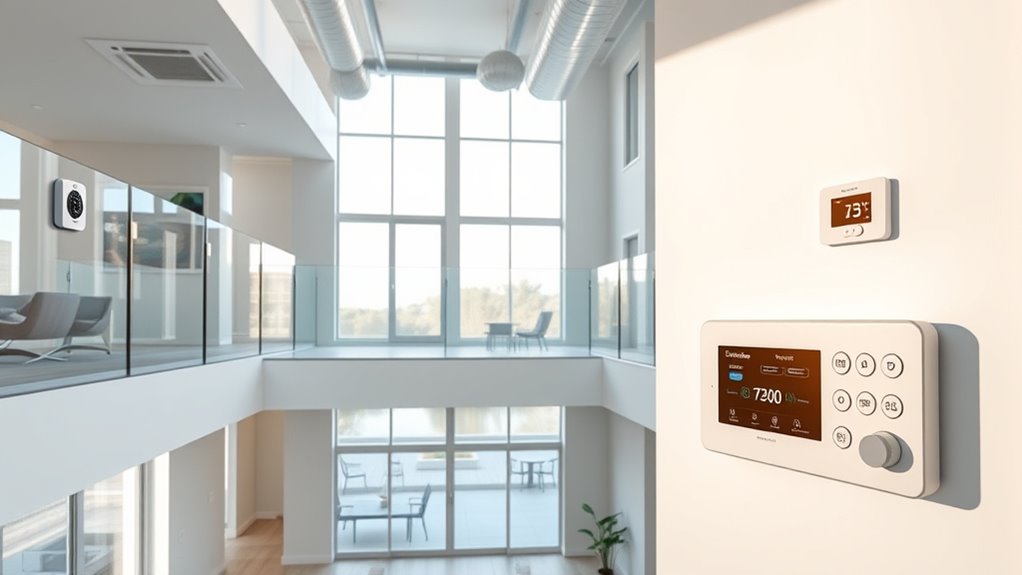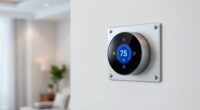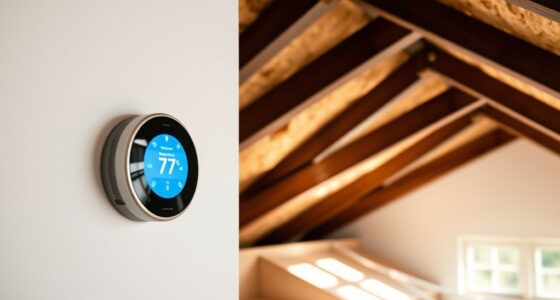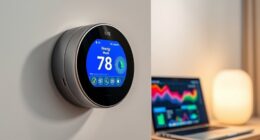To manage temperature efficiently in your multi-story home, consider implementing zoning systems and smart thermostats paired with sensors in different areas. This allows you to control each zone independently, reducing energy waste and maintaining comfort on every level. By adjusting settings based on occupancy and real-time data, you can prevent hot or cold spots and optimize your HVAC use. Keep exploring how these technologies can help you achieve balanced, cost-effective climate control throughout your home.
Key Takeaways
- Install zoning systems to independently control temperatures on different floors, reducing energy waste.
- Use smart thermostats with sensors to monitor real-time temperatures and adjust HVAC operation automatically.
- Set customized schedules for each zone to optimize comfort and minimize unnecessary heating or cooling.
- Seal and insulate your home to improve thermal efficiency and reduce the load on your HVAC system.
- Regularly maintain your HVAC system to ensure efficient performance and prevent energy losses across multiple levels.

Managing temperature in multi-story homes can be challenging, but with the right strategies, you can improve comfort and energy efficiency. One effective approach is to implement zoning systems, which divide your home into separate areas that can be heated or cooled independently. By creating zones, you prevent energy from being wasted on unoccupied or less-used spaces, ensuring each part of your home maintains a comfortable temperature without overworking your HVAC system. Zoning systems give you control over different floors or rooms, allowing you to tailor heating and cooling to your lifestyle and occupancy patterns. This not only enhances comfort but also reduces energy bills, as you’re no longer trying to evenly heat or cool an entire house with diverse thermal needs.
Pairing zoning systems with smart thermostats amplifies their benefits. Smart thermostats learn your schedule and preferences, adjusting temperatures proactively and efficiently. With features like remote control via smartphone apps, you can change settings from anywhere, ensuring your home is cozy when you arrive and conserving energy when you’re away. They also provide detailed energy usage reports, helping you identify patterns and make informed decisions to optimize your system further. Many smart thermostats are compatible with zoning systems, allowing you to set different temperature schedules for each zone effortlessly. This integration provides precise control, making it easier to maintain a balanced and comfortable environment on every floor. Additionally, energy conservation can be significantly improved when these technologies are used together, leading to lower utility bills and a more sustainable home.
To maximize the effectiveness of these tools, consider placing sensors in various zones to monitor temperature more accurately. These sensors feed real-time data to your smart thermostat or zoning system, allowing for automated adjustments that respond to changing conditions. For example, if the upper floor tends to get warmer during the day, your system can automatically lower the cooling in that zone while keeping the lower levels comfortable. This dynamic control helps maintain consistent temperatures across your entire home, preventing hot or cold spots that can cause discomfort and increase energy consumption. Incorporating thermal needs considerations ensures your system is tailored to your home’s unique heating and cooling profile. Additionally, understanding the performance metrics of your HVAC setup can help you fine-tune these systems for maximum efficiency.
Ultimately, managing temperature in multi-story homes becomes much easier when you leverage zoning systems and smart thermostats together. They enable you to customize comfort, reduce energy waste, and streamline your HVAC operation. By investing in these technologies, you’re not just improving your home’s efficiency—you’re creating a more comfortable living environment tailored to your needs. With a bit of setup and adjustment, you’ll enjoy consistent temperatures on every floor, lower utility bills, and a smarter way to manage your home’s climate year-round.
Frequently Asked Questions
How Can I Prevent Hot Air From Rising to Upper Floors?
To prevent hot air from rising to upper floors, focus on improving air circulation and installing thermal barriers. Use ceiling fans to push hot air back down, and guarantee vents are unobstructed for better airflow. Installing thermal barriers or insulation in the attic helps block heat transfer. These steps keep the upper floors cooler, making your home more comfortable and energy-efficient by controlling how heat moves through your space.
What Are the Best Smart Thermostats for Multi-Story Homes?
You should look for smart thermostats with features like multi-zone control and remote sensors to balance temperatures across your home. Brands like Nest or Ecobee offer models with these capabilities. When considering installation, make certain your system supports multi-zone setup and that placement accounts for existing HVAC configurations. These thermostats adapt to your schedule, helping you maintain comfort efficiently on all floors.
How Does Insulation Impact Temperature Management Across Floors?
Think of your home as a layered cake—insulation acts like frosting, preventing heat from escaping or entering. Good insulation enhances thermal resistance, making it more effective at maintaining consistent temperatures across floors. Without proper insulation, warm air rises and cool air sinks unevenly, causing discomfort. Investing in quality insulation boosts insulation effectiveness, helping you save energy and keep every floor cozy and balanced.
Are Zoning Systems Effective for Multi-Story Temperature Control?
A zoning system is highly effective for multi-story temperature control. It offers zoning system benefits like tailored comfort and energy savings. When considering zoning installation considerations, guarantee proper ductwork and smart thermostats are in place. You can easily adjust temperatures for each zone, reducing energy waste and increasing comfort. Overall, a zoning system simplifies managing different levels, making your home more efficient and comfortable year-round.
What Maintenance Is Needed to Keep HVAC Efficiency Optimal?
Did you know neglecting HVAC maintenance can reduce efficiency by up to 20%? To keep your system running smoothly, regularly check and replace your air filters, ideally every 1-3 months. Also, schedule duct cleaning at least once a year to remove dust and debris. These simple steps improve airflow, reduce energy costs, and extend your HVAC system’s lifespan, ensuring excellent comfort in your home.
Conclusion
Remember, managing temperature in your multi-story home is like balancing a delicate orchestra—you’re the conductor. By adjusting vents, sealing leaks, and using smart thermostats, you create harmony from top to bottom. Just as Da Vinci’s genius brought art and science together, your efforts blend comfort with efficiency. Keep fine-tuning your system, and you’ll enjoy a cozy home that’s both warm and smart—truly a masterpiece of comfort and savings.









